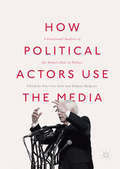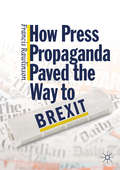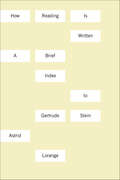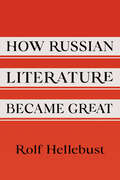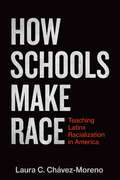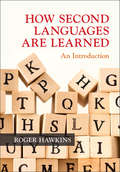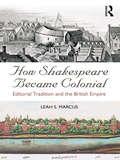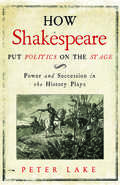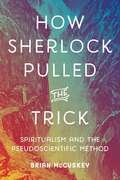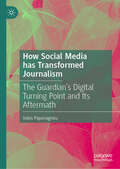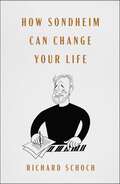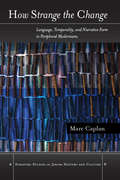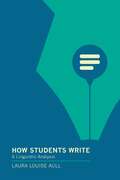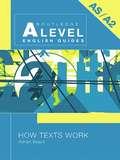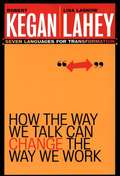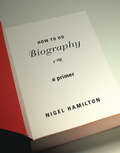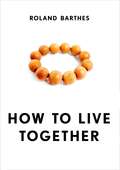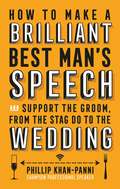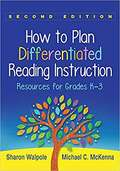- Table View
- List View
How Political Actors Use the Media
by Stefaan Walgrave Peter Van AelstThis book investigates how individual politicians and political parties strategically make use of the media to reach their political goals. Looking beyond a purely Americentric viewpoint, the chapters present data from more than ten Western democracies to argue that the media are both a source of information and an arena for political communication. This double functional role of the media is examined from both a theoretical and an empirical perspective, including chapters dealing with different aspects of politics - from campaigning to law making - and within different political contexts. The role of the news media is discussed from the perspective of the political actor, focusing on both the opportunities and the constraints the news media provide, resulting in a multidisciplinary text that will appeal to students and scholars of both communication and political science.
How Press Propaganda Paved the Way to Brexit
by Francis RawlinsonThis book traces how right-wing newspapers in Britain helped shape British public opinion about the European Union over the course of the 20 years preceding the EU referendum in June 2016. The author argues that newspapers such as the Telegraph, Mail, Sun and Express have been effectively waging a long-term propaganda war, with the distortions and borderline fake news presented one of the factors that helped secure the narrow majority for Brexit. Written by an EU insider, the book presents hard facts and debunks the core myths on EU laws, exorbitant budget contributions and uncontrolled immigration, and contributes to the broader debate on the importance of the press for democracy.
How Reading Is Written: A Brief Index to Gertrude Stein
by Astrid LorangeGertrude Stein is a seminal figure in modern and postmodern literature, yet her work is not easily defined and has had both fierce supporters and equally fierce detractors. In a series of linked essays, How Reading Is Written considers a set of questions associated with reading Gertrude Stein today. In particular, how can we read a body of work that is largely resistant to conventional and interpretation-based models of literary criticism? The book is structurally and conceptually an index to Stein's poetics, and it considers Stein alongside other writers and thinkers, and across discourses of philosophy, science, queer theory, and literary criticism. Like Charles Olson's Call Me Ishmael and Susan Howe's My Emily Dickinson, How Reading Is Written joins a tradition of books by poets about the writers who have intensely figured into their conception of poetry. Astrid Lorange recovers previously overlooked critical work on Stein and aims to construct a new intellectual episteme for Stein's work—one that connects with contemporary contexts as well as repositions Stein in her moment of transnational modernism.
How Russian Literature Became Great (NIU Series in Slavic, East European, and Eurasian Studies)
by Rolf HellebustHow Russian Literature Became Great explores the cultural and political role of a modern national literature, orchestrated in a Slavonic key but resonating far beyond Russia's borders. Rolf Hellebust investigates a range of literary tendencies, philosophies, and theories from antiquity to the present: Roman jurisprudence to German Romanticism, French Enlightenment to Czech Structuralism, Herder to Hobsbawm, Samuel Johnson to Sainte-Beuve, and so on. Besides the usual Russian suspects from Pushkin to Chekhov, Hellebust includes European writers: Byron and Shelley, Goethe and Schiller, Chateaubriand and Baudelaire, Dante, Mickiewicz, and more. As elsewhere, writing in Russia advertises itself via a canon of literary monuments constituting an atemporal "ideal order among themselves" (T.S. Eliot). And yet this is a tradition that could only have been born at a specific moment in the golden nineteenth-century age of historiography and nation-building. The Russian example reveals the contradictions between immutability and innovation, universality and specificity at the heart of modern conceptions of tradition from Sainte-Beuve through Eliot and down to the present day. The conditions of its era of formation—the prominence of the crucial literary-historical question of the writer's social function, and the equation of literature with national identity—make the Russian classical tradition the epitome of a unified cultural text, with a complex narrative in which competing stories of progress and decline unfold through the symbolic biographical encounters of the authors who constitute its members. How Russian Literature Became Great thus offers a new paradigm for understanding the paradoxes of modern tradition.
How Schools Make Race: Teaching Latinx Racialization in America (Race and Education)
by Laura C. Chávez-MorenoAn investigation into how schooling can enhance and hinder critical-racial consciousness through the making of the Latinx racialized group
How Second Languages are Learned: An Introduction
by Roger HawkinsA comprehensive introduction to how people learn second languages (L2s), this textbook approaches the topic through five problems the L2 learner has to solve: 'breaking into' the L2; associating forms with meanings; learning sentence structure; learning phrasal and sentential meaning; and learning the use of the L2 in context. These problems are linked throughout to the L2 acquisition of lexis, morphology, syntax, semantics, phonetics/phonology and language-use in a reader-friendly way, using key studies to build a comprehensive picture of how L2s are learned. 'In a nutshell' summaries of chapter sections provide helpful signposts to the developing argument, whilst end-of-chapter activities encourage the reader to reflect on the ideas presented, analyse data and think creatively about the problems encountered. The roles of innate knowledge, input, and the age at which learning starts are also considered. This essential textbook will enable students to think objectively about language, and will be an asset to any introductory course on second language acquisition.
How Shakespeare Became Colonial: Editorial Tradition and the British Empire
by Leah S. MarcusIn this fascinating book, Leah S. Marcus argues that the colonial context in which Shakespeare was edited and disseminated during the heyday of the British Empire has left a mark on Shakespeare’s texts to the present day. How Shakespeare Became Colonial offers a unique and engaging argument, including: A brief history of the colonial importance of editing Shakespeare; The colonially inflected racism that hides behind the editing of Othello; The editing of female characters – colonization as sexual conquest; The significance of editions that were specifically created for schools in India during British colonial rule. Marcus traces important ways in which the colonial enterprise of setting forth the best possible Shakespeare for world consumption has continued to be visible in the recent treatment of his playtexts today, despite our belief that we are global or postcolonial in approach.
How Shakespeare Put Politics on the Stage: Power and Succession in the History Plays
by Peter LakeA masterful, highly engaging analysis of how Shakespeare's plays intersected with the politics and culture of Elizabethan England With an ageing, childless monarch, lingering divisions due to the Reformation, and the threat of foreign enemies, Shakespeare's England was fraught with unparalleled anxiety and complicated problems. In this monumental work, Peter Lake reveals, more than any previous critic, the extent to which Shakespeare's plays speak to the depth and sophistication of Elizabethan political culture and the Elizabethan imagination. Lake reveals the complex ways in which Shakespeare's major plays engaged with the events of his day, particularly regarding the uncertain royal succession, theological and doctrinal debates, and virtue and virt#65533; in politics. Through his plays, Lake demonstrates, Shakespeare was boldly in conversation with his audience about a range of contemporary issues. This remarkable literary and historical analysis pulls the curtain back on what Shakespeare was really telling his audience and what his plays tell us today about the times in which they were written.
How Sherlock Pulled the Trick: Spiritualism and the Pseudoscientific Method
by Brian McCuskeyA masterful combination of literary study and author biography, How Sherlock Pulled the Trick guides us through the parallel careers of two inseparable men: Sherlock Holmes and his creator, Sir Arthur Conan Doyle. Reconsidering Holmes in light of Doyle’s well-known belief in Victorian spiritualism, Brian McCuskey argues that the so-called scientific detective follows the same circular logic, along the same trail of questionable evidence, that led Doyle to the séance room.Holmes’s first case, A Study in Scarlet, was published in 1887, when natural scientists and religious apologists were hotly debating their differences in the London press. In this environment, Doyle became convinced that spiritualism, as a universal faith based on material evidence, resolved the conflict between science and religion. The character of Holmes, with his infallible logic, was Doyle’s good faith solution to the cultural conflicts of his day. Yet this solution has evolved into a new problem. Sherlock Holmes now authorizes the pseudoscience that corrupts our public sphere, defying logic, revising history, and promoting conspiracy theories. As this book demonstrates, wearing a deerstalker does not make you a mastermind—more likely, it marks you as a crackpot.Fascinating and highly readable, How Sherlock Pulled the Trick returns the iconic Holmes to his mystical origins.
How Sherlock Pulled the Trick: Spiritualism and the Pseudoscientific Method
by Brian McCuskeyA masterful combination of literary study and author biography, How Sherlock Pulled the Trick guides us through the parallel careers of two inseparable men: Sherlock Holmes and his creator, Sir Arthur Conan Doyle. Reconsidering Holmes in light of Doyle’s well-known belief in Victorian spiritualism, Brian McCuskey argues that the so-called scientific detective follows the same circular logic, along the same trail of questionable evidence, that led Doyle to the séance room.Holmes’s first case, A Study in Scarlet, was published in 1887, when natural scientists and religious apologists were hotly debating their differences in the London press. In this environment, Doyle became convinced that spiritualism, as a universal faith based on material evidence, resolved the conflict between science and religion. The character of Holmes, with his infallible logic, was Doyle’s good faith solution to the cultural conflicts of his day. Yet this solution has evolved into a new problem. Sherlock Holmes now authorizes the pseudoscience that corrupts our public sphere, defying logic, revising history, and promoting conspiracy theories. As this book demonstrates, wearing a deerstalker does not make you a mastermind—more likely, it marks you as a crackpot.Fascinating and highly readable, How Sherlock Pulled the Trick returns the iconic Holmes to his mystical origins.
How Social Media has Transformed Journalism: The Guardian’s Digital Turning Point and Its Aftermath
by Vaios PapanagnouThis book explores the influence of social media on the transformation of institutional journalism. Grounded on a case study of The Guardian in the UK, the work is an in-depth look at how a leading news organisation navigated the challenges of the social media era. Drawing on interviews with Guardian journalists, Papanagnou demonstrates that the major change that social media effected on journalism has been the inculcation of journalists with the logic of branding. Journalists now actively brand themselves and their organisations as authoritative voices on public affairs; they emphasise their expertise in the stories they share across platforms, leveraging their reputations to establish credibility and connect with like-minded audiences. Ultimately, the author argues that the turn to branding represents a pragmatic solution to the problem that social media companies posed for journalism. By embracing networking technologies, journalists and their organisations have become increasingly tethered to big-tech. And, lacking the immense technological and financial resources of the digital platforms, news brands and their journalists have sought to counteract this dependency by wielding the power of their journalistic reputations.
How Societies Remember
by Paul ConnertonIn treating memory as a cultural rather than an individual faculty, this book provides an account of how bodily practices are transmitted in, and as, traditions. Most studies of memory as a cultural faculty focus on written, or inscribed transmissions of memories. Paul Connerton, on the other hand, concentrates on bodily (or incorporated) practices, and so questions the currently dominant idea that literary texts may be taken as a metaphor for social practices generally. The author argues that images of the past and recollected knowledge of the past are conveyed and sustained by ritual performances and that performative memory is bodily. Bodily social memory is an essential aspect of social memory, but it is an aspect which has until now been badly neglected. An innovative study, this work should be of interest to researchers into social, political and anthropological thought as well as to graduate and undergraduate students.
How Sondheim Can Change Your Life
by Richard SchochDiscover the powerful and universal lessons from the music and lyrics of Stephen Sondheim, the genius behind such musical theater masterworks as Company, West Side Story, and Into the Woods.Stephen Sondheim died on November 26, 2021, but for countless fans around the world, he is &“still here,&” to quote one of his lyrics. With acclaimed revivals of his landmark shows occurring around the world and introducing new generations to the man who transformed American musical theater, Sondheim&’s legacy has only grown. What is it about such classic songs as &“Rose&’s Turn&” from Gypsy, &“Send in the Clowns&” from A Little Night Music, and &“Children Will Listen&” from Into the Woods that speaks to us so intimately and profoundly? How Sondheim Can Change Your Life makes the case that Sondheim&’s greatness—beyond the clever lyrics and adventurous music—rests in his ability to tell stories that relate to us all. From Louise&’s desire for freedom as Gypsy Rose Lee to Sweeney Todd&’s thirst for revenge, we as an audience relate easily to Sondheim&’s characters. His works understand us as much as we understand them. Following the arc of Sondheim&’s career, How Sondheim Can Change Your Life is rich with stories about productions and iconic performers, deep readings of his music and lyrics, and insights into his creative process. But more than that, it reveals how Sondheim&’s works can enrich our own lives.
How Spanish Grew
by Robert K. SpauldingThis book traces the evolution of the Spanish language from pre-Roman days to the present and stresses the influence of social and political events on its development. After a short discussion of the Indo-European tongues, Spaulding reviews the effects on Spanish of the languages of the pre-Roiman invaders, the Visigoths and other Germanic tribes, and the Arabs. The later development of Spanish is divided into four periods: Old Spanish (to 1500), Spanish Ascendancy (1500 - 1700), French Prestige (1700 - 1808), and Modern Spanish (1808 - ). Within this framework, the author discusses the evolution of sounds, forms, constructions, style, vocabulary, and orthography. The final chapter deals also with modern slang, popular Spanish, and the various Spanish dialects, including Leonese, Aragonese, and Andalusian. The book has interest and value for anyone interested in language, teachers (both high school and college), and students. Its organization makes it usable in any course dealing with the Spanish language historically, or even by student of Spanish literature of history who wan tot consider the state of the language at a given period. This title is part of UC Press's Voices Revived program, which commemorates University of California Press's mission to seek out and cultivate the brightest minds and give them voice, reach, and impact. Drawing on a backlist dating to 1893, Voices Revived makes high-quality, peer-reviewed scholarship accessible once again using print-on-demand technology. This title was originally published in 1943.
How Strange the Change: Language, Temporality, and Narrative Form in Peripheral Modernisms
by Marc CaplanIn this book, Marc Caplan argues that the literatures of ostensibly marginal modern cultures are key to understanding modernism. Caplan undertakes an unprecedented comparison of nineteenth-century Yiddish literature and twentieth-century Anglophone and Francophone African literature and reveals unexpected similarities between them. These literatures were created under imperial regimes that brought with them processes of modernization that were already well advanced elsewhere. Yiddish and African writers reacted to the liberating potential of modernity and the burdens of imperial authority by choosing similar narrative genres, typically reminiscent of early-modern European literatures: the picaresque, the pseudo-autobiography, satire, and the Bildungsroman. Both display analogous anxieties toward language, caught as they were between imperial, "global" languages and stigmatized native vernaculars, and between traditions of writing and orality. Through comparative readings of narratives by Reb Nakhman of Breslov, Amos Tutuola, Yisroel Aksenfeld, Cheikh Hamidou Kane, Isaac Meyer Dik, Camara Laye, Mendele Moykher-Sforim, Wole Soyinka, Y. Y. Linetski, and Ahmadou Karouma, Caplan demonstrates that these literatures' "belated" relationship to modernization suggests their potential to anticipate subsequent crises in the modernity and post-modernity of metropolitan cultures. This, in turn, leads him to propose a new theoretical model, peripheral modernism, which incorporates both a new understanding of "periphery" and "center" in modernity and a new methodology for comparative literary criticism and theory.
How Students Write: A Linguistic Analysis
by Laura Louise AullBroad generalizations about "people today" are a familiar feature of first-year student writing. How Students Write brings a fresh perspective to this perennial observation, using corpus linguistics techniques. This study analyzes sentence-level patterns in student writing to develop an understanding of how students present evidence, draw connections between ideas, relate to their readers, and, ultimately, learn to construct knowledge in their writing.Drawing on both first-year and upper-level student writing, the book examines the discourse of students at different points in their education. It also distinguishes between argumentative and analytic essays to explore the way school genres and assignments shape students' choices.In focusing on sentence-level features such as hedges ("perhaps") and boosters ("definitely"), this study shows how such rhetorical choices work together to open or close opportunities for thoughtful exchanges of ideas. Attention to these features can help instructors foster civil discourse, design effective assignments, and expose and question norms of higher education.
How Tell a Story and Others
by Mark TwainThe Humorous Story an American Development. Its Difference from Comic and Witty Stories.
How Texts Work
by Adrian BeardHow Texts Work: explores the ways in which we categorize texts reveals the limitations of some of the polarisations we use to categorize texts analyzes a wide variety of texts from a range of genres and periods, from Ibsen's A Doll's House to an 18-30s brochure, Internet chatrooms and George Bush's September 11 speech offers a step-by-step guide to approaching texts and structuring a response can be used as both a course stimulus and a revision tool. Written by an experienced teacher, author and AS and A2 level examiner, How Texts Work is an essential resource for all students of AS and A2 level English Language, English Literature, and English Language and Literature.
How The Way We Talk Can Change The Way We Work: Seven Languages for Transformation
by Lisa Laskow Lahey Robert KeganWhy is the gap so great between our hopes, our intentions, even our decisions-and what we are actually able to bring about? Even when we are able to make important changes-in our own lives or the groups we lead at work-why are the changes are so frequently short-lived and we are soon back to business as usual? What can we do to transform this troubling reality? In this intensely practical book, Harvard psychologists Robert Kegan and Lisa Laskow Lahey take us on a carefully guided journey designed to help us answer these very questions. And not just generally, or in the abstract. They help each of us arrive at our own particular answers that can solve the puzzling gap between what we intend and what we are able to accomplish. How the Way We Talk Can Change the Way We Work provides you with the tools to create a powerful new build-it-yourself mental technology.
How To Be Gay
by David M. HalperinA pioneer of LGBTQ studies dares to suggest that gayness is a way of being that gay men must learn from one another to become who they are. The genius of gay culture resides in some of its most despised stereotypes—aestheticism, snobbery, melodrama, glamour, caricatures of women, and obsession with mothers—and in the social meaning of style.
How To Do Biography: A Primer
by Nigel HamiltonIt is not surprising that biography is one of the most popular literary genres of our day. What is remarkable is that there is no accessible guide for how to write one. Now, following his recent Biography: A Brief History (from Harvard), award-winning biographer and teacher Nigel Hamilton tackles the practicalities of doing biography in this first succinct primer to elucidate the tools of the biographer’s craft. Hamilton invites the reader to join him on a fascinating journey through the art of biographical composition. Starting with personal motivation, he charts the making of a modern biography from the inside: from conception to fulfillment. He emphasizes the need to know one’s audience, rehearses the excitement and perils of modern research, delves into the secrets of good and great biography, and guides the reader through the essential components of life narrative. With examples taken from the finest modern biographies, Hamilton shows how to portray the ages of man—birth, childhood, love, life’s work, the evening of life, and death. In addition, he suggests effective ways to start and close a life story. He clarifies the difference between autobiography and memoir—and addresses the sometimes awkward ethical, legal, and personal consequences of truth-telling in modern life writing. He concludes with the publication and reception of biography—its afterlife, so to speak. Written with humor, insight, and compassion, How To Do Biography is the manual that would-be biographers have long been awaiting.
How To Live Together: Novelistic Simulations Of Some Everyday Spaces (European Perspectives: A Series In Social Thought And Cultural Criticism)
by Roland BarthesOn March 14, 1976, following a recommendation made by Michel Foucault, the committee of professors elected Roland Barthes to Chair of Literary Semiology. The new professor would teach at the Collège de France until his death in the spring of 1980. The uncertain trajectory of Roland Barthes's career has often been noted: an academic with no agrégation qualification, a singular researcher who had spent much of his working life either abroad (Romania, Egypt, Morocco) or in the margins of the French university system. Barthes's meandering path culminated in a prestigious setting; even so, his election, secured by just a single vote, serves as a reminder of the intellectual and institutional resistance that has so often stalled the advancement of a singular thinker...
How To Make a Brilliant Best Man's Speech: and support the groom, from the stag do to the wedding
by Phillip Khan-PanniHow to make a great, best man's speech - and a guide to being a great best man.In this book Phillip Khan-Panni uses his expertise as a champion professional speaker to help the best man with the terrifying prospect of writing and delivering The Speech.He guides you on the vital preparation of your speech and tells you how to use stories, jokes and quotations that will lift it well above the bare necessities. With the author`s help and his professional tips and techniques, you will be able to make a really entertaining and moving speech that will be remembered for a long time to come. You might even enjoy making it as much as the guests do hearing it!There are also checklists and further advice to help you organise the whole occasion so that the big day honours the groom and his bride and thoroughly impresses their friends and relations
How To Make a Brilliant Best Man's Speech: and support the groom, from the stag do to the wedding
by Phillip Khan-PanniHow to make a great, best man's speech - and a guide to being a great best man.In this book Phillip Khan-Panni uses his expertise as a champion professional speaker to help the best man with the terrifying prospect of writing and delivering The Speech.He guides you on the vital preparation of your speech and tells you how to use stories, jokes and quotations that will lift it well above the bare necessities. With the author`s help and his professional tips and techniques, you will be able to make a really entertaining and moving speech that will be remembered for a long time to come. You might even enjoy making it as much as the guests do hearing it!There are also checklists and further advice to help you organise the whole occasion so that the big day honours the groom and his bride and thoroughly impresses their friends and relations
How To Plan Differentiated Reading Instruction: Resources For Grades K-3
by Sharon Walpole Michael C. McKennaTens of thousands of K–3 teachers have relied on this book--now revised and expanded with more than 50% new material--to plan and deliver effective literacy instruction tailored to each student's needs. The authors provide a detailed framework for implementing differentiated small-group instruction over multiweek cycles. Each component of the beginning reading program is addressed--phonological awareness, word recognition, fluency, vocabulary, and comprehension. In a large-size format with lay-flat binding for easy photocopying, the book includes dozens of reproducible lesson plans, instructional activities, assessment forms, and other tools. Purchasers get access to a Web page where they can download and print the reproducible materials.
